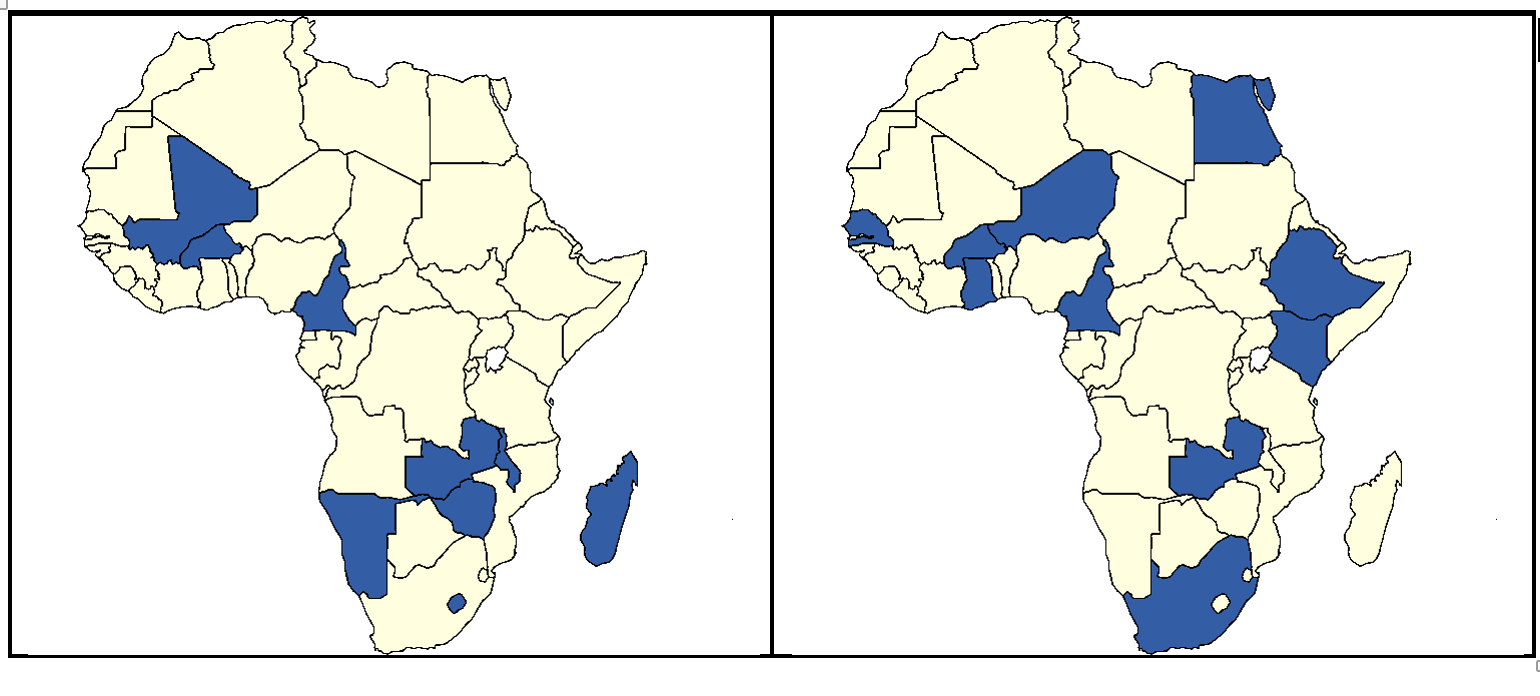
Published 2025-07-08
Keywords
- climate change,
- Sub-Saharan Africa,
- smallholder agriculture,
- livestock
How to Cite
Copyright (c) 2025 Forrest W. Stagner

This work is licensed under a Creative Commons Attribution 4.0 International License.
Abstract
Climate change threatens the livelihoods of smallholders (i.e., smallholder farmers, pastoralists, agro-pastoralists) in Sub-Saharan Africa (SSA) because of their exposure and sensitivity to the surrounding environment, including increases in temperature and changes to rainfall patterns. Scholars have argued that these environmental changes will compel crop farmers to increasingly adopt livestock because they are less vulnerable to environmental shocks than rainfed crops since livestock can be moved to access feed and water. While evidence exists that smallholders prefer different livestock species due at least in part to ecological conditions, the effects of shocks on smallholder livestock ownership in SSA remain understudied. This study investigates the impact of climatic shocks on livestock ownership in SSA using binary, ordinal, and multinomial logistic regression analyses. It finds that, under conditions of unusually high heat and low rainfall, smallholders are more likely to own livestock, more likely to diversify herds, and more likely to own smaller livestock like goats and chickens than large livestock like cattle. These findings provide important insights to help manage adversity due to climate change for vulnerable smallholders. These efforts, moreover, would be improved with more data collection and analysis.
References
- Alfani, F., Arslan, A., McCarthy, N., Cavatassi, R., & Sitko, N. (2021). Climate resilience in rural Zambia: Evaluating farmers’ response to El Niño-induced drought. Environment and Development Economics, 26(5-6), 582-604. DOI: https://doi.org/10.1017/S1355770X21000097
- Anbacha, A. E., & Kjosavik, D. J. (2021). Pastoral livelihood diversification and gender in Borana, Southern Ethiopia. Rangeland Ecology & Management, 79, 1-12. DOI: https://doi.org/10.1016/j.rama.2021.06.006
- Bedelian, C., & Ogutu, J. O. (2017). Trade-offs for climate-resilient pastoral livelihoods in wildlife conservancies in the Mara ecosystem, Kenya. Pastoralism, 7(1), 1-22. DOI: https://doi.org/10.1186/s13570-017-0085-1
- Berhanu, W., & Beyene, F. (2015). Climate variability and household adaptation strategies in southern Ethiopia. Sustainability, 7(6), 6353-6375. DOI: https://doi.org/10.3390/su7066353
- Boyle, E.H., King, M. & Sobek, M. IPUMS-Demographic and Health Surveys: Version 9 [dataset]. IPUMS and ICF, 2022. https://doi.org/10.18128/D080.V9
- Cuni-Sanchez, A., Omeny, P., Pfeifer, M., Olaka, L…, & Burgess, N. D. (2019). Climate change and pastoralists: Perceptions and adaptation in montane Kenya. Climate and Development, 11(6), 513-524. DOI: https://doi.org/10.1080/17565529.2018.1454880
- Intergovernmental Panel on Climate Change (IPCC). (2014). Climate Change 2014: Impacts, Adaptation, and Vulnerability. Part A: Global and Sectoral Aspects. Contribution of Working Group II to the Fifth Assessment Report of the Intergovernmental Panel on Climate Change [Field, C.B., V.R. Barros, D.J. Dokken...L.L. White (eds.)]. Cambridge, UK and New York, USA: Cambridge University Press.
- Jones, P. G., & Thornton, P. K. (2009). Croppers to livestock keepers: Livelihood transitions to 2050 in Africa due to climate change. Environmental Science and Policy, 12(4), 427–437. DOI: https://doi.org/10.1016/j.envsci.2008.08.006
- Kabubo‐Mariara, J. (2008). Climate change adaptation and livestock activity choices in Kenya: An economic analysis. Natural Resources Forum, 32(2), 131-141. DOI: https://doi.org/10.1111/j.1477-8947.2008.00178.x
- Kurgat, B. K., Lamanna, C., Kimaro, A., Namoi, N…, & Rosenstock, T. S. (2020). Adoption of climate-smart agriculture technologies in Tanzania. Frontiers in Sustainable Food Systems, 4, 55. DOI: https://doi.org/10.3389/fsufs.2020.00055
- Leauthaud, C., Duvail, S., Hamerlynck, O., Paul, J. L…, & Grünberger, O. (2013). Floods and livelihoods: The impact of changing water resources on wetland agro-ecological production systems in the Tana River Delta, Kenya. Global environmental change, 23(1), 252-263. DOI: https://doi.org/10.1016/j.gloenvcha.2012.09.003
- Liao, C., Ruelle, M. L., & Kassam, K. A. S. (2016). Indigenous ecological knowledge as the basis for adaptive environmental management: Evidence from pastoralist communities in the Horn of Africa. Journal of Environmental Management, 182, 70-79. DOI: https://doi.org/10.1016/j.jenvman.2016.07.032
- Lumborg, S., Tefera, S., Munslow, B., & Mor, S. M. (2021). Examining local perspectives on the influence of climate change on the health of Hamer pastoralists and their livestock in Ethiopia. Pastoralism, 11(1), 1-17. DOI: https://doi.org/10.1186/s13570-021-00191-8
- Manoli, C., Ancey, V., Corniaux, C., Ickowicz, A…, & Moulin, C. H. (2014). How do pastoral families combine livestock herds with other livelihood security means to survive? The case of the Ferlo area in Senegal. Pastoralism, 4(1), 1-11. DOI: https://doi.org/10.1186/2041-7136-4-3
- Mihiretu, A., Okoyo, E. N., & Lemma, T. (2019). Determinants of adaptation choices to climate change in agro-pastoral dry lands of Northeastern Amhara, Ethiopia. Cogent Environmental Science, 5(1), 1636548. DOI: https://doi.org/10.1080/23311843.2019.1636548
- Musinguzi, L., Efitre, J., Odongkara, K., Ogutu-Ohwayo, R…, & Naigaga, S. (2016). Fishers’ perceptions of climate change, impacts on their livelihoods and adaptation strategies in environmental change hotspots: A case of Lake Wamala, Uganda. Environment, Development and Sustainability, 18(4), 1255-1273. DOI: https://doi.org/10.1007/s10668-015-9690-6
- Opiyo, F., Wasonga, O., Nyangito, M., Schilling, J., & Munang, R. (2015). Drought adaptation and coping strategies among the Turkana pastoralists of northern Kenya. International Journal of Disaster Risk Science, 6(3), 295-309. DOI: https://doi.org/10.1007/s13753-015-0063-4
- Salamula, J. B., Egeru, A., Asiimwe, R., Aleper, D. K., & Namaalwa, J. J. (2017). Socio-economic determinants of pastoralists’ choice of camel production in Karamoja sub-region, Uganda. Pastoralism, 7(1), 1-10. DOI: https://doi.org/10.1186/s13570-017-0096-y
- Seo, S. N., & Mendelsohn, R. (2008). Measuring impacts and adaptations to climate change: a structural Ricardian model of African livestock management. Agricultural economics, 38(2), 151-165. DOI: https://doi.org/10.1111/j.1574-0862.2007.00289.x
- Thornton, P. K., Ericksen, P. J., Herrero, M., & Challinor, A. J. (2014) Climate variability and vulnerability to climate change: A review. Global Change Biology, 20, 3313–3328. DOI: https://doi.org/10.1111/gcb.12581
- Watson, E. E., Kochore, H. H., & Dabasso, B. H. (2016). Camels and climate resilience: Adaptation in northern Kenya. Human Ecology, 44(6), 701-713. DOI: https://doi.org/10.1007/s10745-016-9858-1
- Zampaligré, N., Dossa, L. H., & Schlecht, E. (2014). Climate change and variability: perception and adaptation strategies of pastoralists and agro-pastoralists across different zones of Burkina Faso. Regional Environmental Change, 14(2), 769-783. DOI: https://doi.org/10.1007/s10113-013-0532-5




